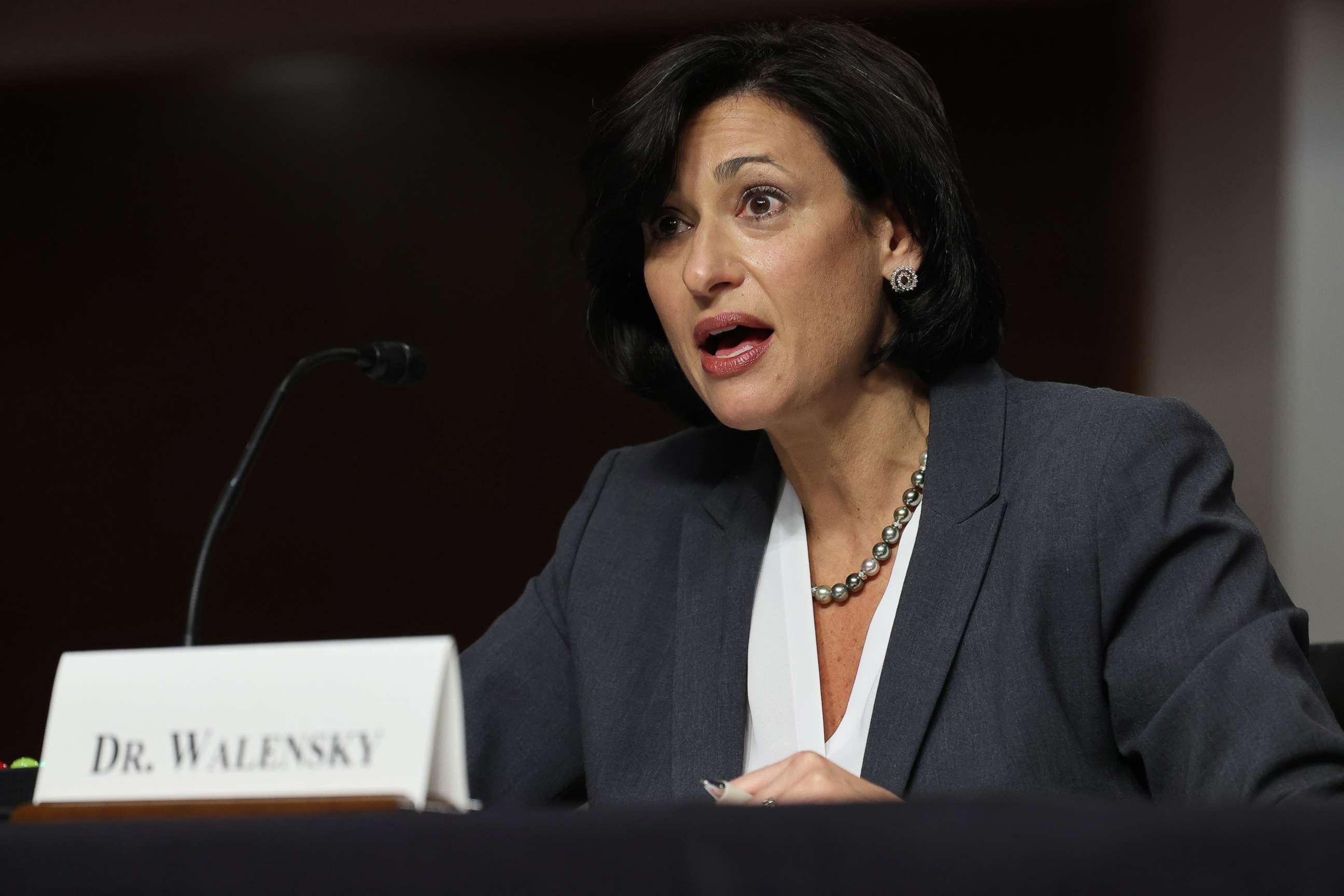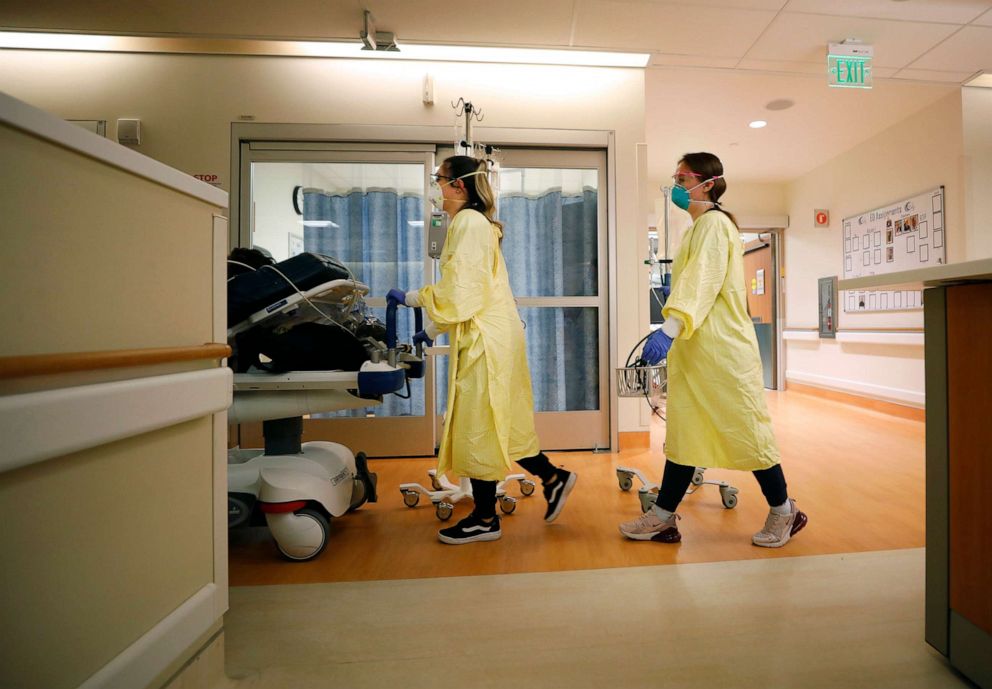CDC director says US may see 'precipitous decline' in omicron cases like South Africa
But Dr. Rochelle Walensky warned the U.S. is a much bigger country.
Centers for Disease Control and Prevention Director Rochelle Walensky said Friday there is a good chance that the U.S. will follow the "ice-pick"-shaped curve of South Africa's omicron surge of the COVID variant, but cautioned that it could roll through different parts of the country at various times, as previous waves have.
"I do think in places that we are seeing this really steep incline, that we may well see also a precipitous decline, but we're also a much bigger country than South Africa," Walensky said in a briefing with reporters.
"And so it may very well be that we see this ice-pick shape, but that is it travels across the country," she said.
As far as the rapid spread of coronavirus cases contributing to that decline, Walensky said there was not yet conclusive data to say for sure that people who recovered from omicron would be protected against reinfection. The CDC is setting up studies to find out more, Walensky said.
There is data to show that previous delta infections do not fully protect against omicron infections, but that lab studies have shown omicron infection may protect against future delta infections, she said.
"But we don't yet have data that has demonstrated, at least clinically, that omicron protects against omicron," Walensky said. "We are setting up studies to evaluate that, but we don't have that information quite yet."

Would a fourth shot help?
Israel has rolled out fourth shots to certain at-risk members of the public, including health care workers and elderly people. Walensky said the U.S. would have to boost millions more Americans before considering another round. Just 35% of the population, or 73 million people, have been boosted -- and about 60% of those over 65 have, according to the CDC's data.
"Right now, I think our strategy has to be to maximize the protection of the tens of millions of people who continue to be eligible for a third shot before we start thinking about what a fourth shot would look like," Walensky said.
As for the record-breaking high rates of pediatric hospitalizations, Walensky described a culmination of winter bringing higher rates of hospitalizations, many kids testing positive in hospitals when they come in for other issues and the low vaccination rates among kids in the face of the most transmissible variant yet.
For the week ending Jan. 1, Walensky said the rate of hospitalization for kids up to age four was 4.3 per 100,000, but that the population over 65 was seeing rates of 14.7 hospitalizations per 100,000.
"So, rates are higher in the pediatric populations than we've seen previously, but they're also higher among our other populations and many populations that are also vaccinated," Walensky said, reflecting how much the virus has spread.
Still, she said there is not data to show its more severe in kids than in other age groups.
"We are following the science carefully on that," she said. "We have not yet seen that signal."
More briefings coming
And after weeks of confusion and criticism over the latest CDC guidelines on isolation, Walensky also acknowledged that running public health messaging in a pandemic is "hard" and she is "committed" to improving.
As part of the commitment, she said she would add regular press briefings to her schedule, where she will take questions from the press solo and directly -- not an unusual practice, as many CDC directors have held regular briefings and the FDA currently does so, but one that was replaced during Walensky's tenure with her weekly appearances at White House briefings.
"This is hard and I am committed to continue to improve as we learn more about the science, and to communicate that with all of you," Walensky said.
"For the last year I've taken your questions in about 80, over 80 briefings since I took office and oftentimes multiple times a week. But I hear that you are interested in hearing from the CDC independently and we are eager to answer your questions and I will continue to engage with you. So I anticipate that this will be the first of many briefings and I very much look forward to them," she said.
Walensky said she began those briefings Friday because "we had heard clearly over the last week that there was interest in hearing from us independently."
She was pressed repeatedly for clarifications on the updated isolation guidelines that kicked off the confusion, which call for Americans to isolate for five days if they have COVID-19, with day 0 being either the day they test positive or the day they come down with symptoms -- whichever happens last -- and then re-enter society with caution, wearing a mask and avoiding risky activities.
"If day zero is your first day of feeling any symptoms and day one is your first full day of symptoms, what we're saying is on day five, do you still have symptoms? And if you are symptom free on day five, then you can think about leaving isolation on day six, as long as you're reliably wearing a well fitted mask," she said.
She also said to "anticipate that you might have some residual contagion in you" for days six through 10, which is why they recommend against dining at restaurants, seeing elderly, high-risk people or traveling.

"One of the challenges that we're having now, unlike prior waves in this pandemic, is not that we don't have enough beds, but that we don't necessarily have enough staffing for those beds. And we were really seeing hospital health care work staffing as a real challenge just as the holidays were hitting, and it was a reason for our swift action," Walensky said.
Pushed on why testing wasn't a component, which has been criticized by some public health experts who fear people will prematurely leave isolation and spread the virus, Dr. Henry Walke, the Director of the Division of Preparedness and Emerging Infections at the CDC, said that its "unclear" what a negative rapid test late in the course of illness means.
"The tests that we have for SARS-CoVi-2 are really best used early in the course of illness to diagnose COVID-19 and really aren't authorized by the US FDA to evaluate the duration of infectiousness. So the significance of a negative antigen test, for example, late in the course of illness, after you've become positive is really -- it's unclear what that means," Walke said.
"A negative antigen test doesn't necessarily mean that there's an absence of a virus. So regardless of the test result, wearing a well-fitting mask after those five days of isolation is still recommended," Walke said.
PCR tests, which are slower but considered the "gold standard" of tests, can return positive results to people who've had COVID for up to 12 weeks after infection, so they can't be used for the purpose of ending isolation.
Walensky was clear that the guidelines stemmed from a need to keep critical workers in the field.
She said they predicted that the health care workforce would be "a harbinger of other things to come" in critical areas like pharmacies, police forces, EMTs, and other sectors.
Walensky defended the guidance as "grounded in science," but acknowledged that they were based largely on data from past variants because the CDC is "unlikely to have detailed data for omicron in exactly the same way for weeks to come."




